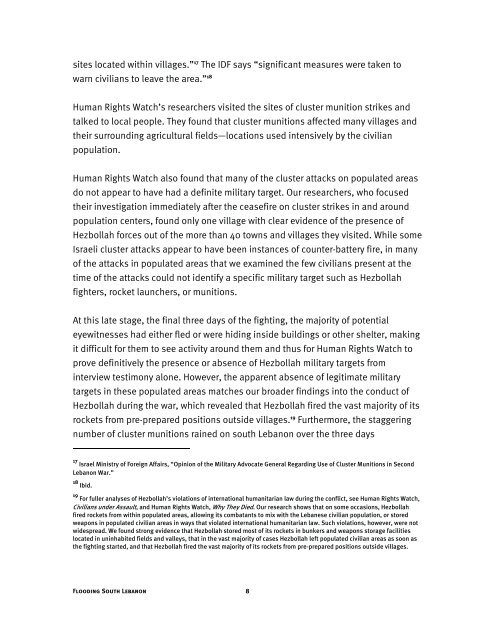Flooding South Lebanon - Human Rights Watch
Flooding South Lebanon - Human Rights Watch
Flooding South Lebanon - Human Rights Watch
You also want an ePaper? Increase the reach of your titles
YUMPU automatically turns print PDFs into web optimized ePapers that Google loves.
sites located within villages.” 17 The IDF says “significant measures were taken to<br />
warn civilians to leave the area.” 18<br />
<strong>Human</strong> <strong>Rights</strong> <strong>Watch</strong>’s researchers visited the sites of cluster munition strikes and<br />
talked to local people. They found that cluster munitions affected many villages and<br />
their surrounding agricultural fields—locations used intensively by the civilian<br />
population.<br />
<strong>Human</strong> <strong>Rights</strong> <strong>Watch</strong> also found that many of the cluster attacks on populated areas<br />
do not appear to have had a definite military target. Our researchers, who focused<br />
their investigation immediately after the ceasefire on cluster strikes in and around<br />
population centers, found only one village with clear evidence of the presence of<br />
Hezbollah forces out of the more than 40 towns and villages they visited. While some<br />
Israeli cluster attacks appear to have been instances of counter-battery fire, in many<br />
of the attacks in populated areas that we examined the few civilians present at the<br />
time of the attacks could not identify a specific military target such as Hezbollah<br />
fighters, rocket launchers, or munitions.<br />
At this late stage, the final three days of the fighting, the majority of potential<br />
eyewitnesses had either fled or were hiding inside buildings or other shelter, making<br />
it difficult for them to see activity around them and thus for <strong>Human</strong> <strong>Rights</strong> <strong>Watch</strong> to<br />
prove definitively the presence or absence of Hezbollah military targets from<br />
interview testimony alone. However, the apparent absence of legitimate military<br />
targets in these populated areas matches our broader findings into the conduct of<br />
Hezbollah during the war, which revealed that Hezbollah fired the vast majority of its<br />
rockets from pre-prepared positions outside villages. 19 Furthermore, the staggering<br />
number of cluster munitions rained on south <strong>Lebanon</strong> over the three days<br />
17 Israel Ministry of Foreign Affairs, “Opinion of the Military Advocate General Regarding Use of Cluster Munitions in Second<br />
<strong>Lebanon</strong> War.”<br />
18 Ibid.<br />
19 For fuller analyses of Hezbollah’s violations of international humanitarian law during the conflict, see <strong>Human</strong> <strong>Rights</strong> <strong>Watch</strong>,<br />
Civilians under Assault, and <strong>Human</strong> <strong>Rights</strong> <strong>Watch</strong>, Why They Died. Our research shows that on some occasions, Hezbollah<br />
fired rockets from within populated areas, allowing its combatants to mix with the Lebanese civilian population, or stored<br />
weapons in populated civilian areas in ways that violated international humanitarian law. Such violations, however, were not<br />
widespread. We found strong evidence that Hezbollah stored most of its rockets in bunkers and weapons storage facilities<br />
located in uninhabited fields and valleys, that in the vast majority of cases Hezbollah left populated civilian areas as soon as<br />
the fighting started, and that Hezbollah fired the vast majority of its rockets from pre-prepared positions outside villages.<br />
<strong>Flooding</strong> <strong>South</strong> <strong>Lebanon</strong> 8
















